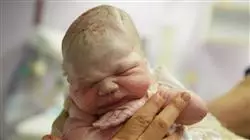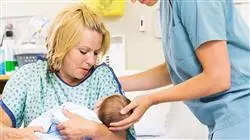University certificate
The world's largest faculty of nursing”
Introduction to the Program
The care of the woman after childbirth must be carried out with extreme care, due to the pathologies that can arise in the Puerperium for Midwives"

After childbirth, women need a period of time to recover their usual conditions, both hormonal and of the female reproductive system. During this period of puerperium, complications may arise in women's health, so it is important that professionals working in the field of gynecology specialize in this area.
The up to date contents of this Masters Degree and its integrative approach will give rise to a complete vision of all aspects related to the Puerperium. The contents will provide a journey through the various needs of the woman and the newborn during the Puerperium, both in physiological situations and in those that deviate from normality.
Both the design of the program and the didactic material used will facilitate the understanding of concepts, and the realization of practical cases will help to adapt what has been learned to clinical practice. In this way, the Masters Degree will provide immersive learning in order to train professionals in real situations of their daily professional practice.
Don’t miss this opportunity to study in the largest private online university”
This Masters Degree in Puerperium for Midwives contains the most complete and up to date scientific program on the market. The most important features of the program include:
- The development of case studies presented by Puerperium experts
- The graphic, schematic, and eminently practical contents with which they are created, provide scientific and practical information on the disciplines that are essential for professional practice
- News about the puerperium period
- Practical exercises where the self assessment process can be carried out to improve learning
- Special emphasis on innovative methodologies in the Puerperium
- Theoretical lessons, questions to the expert, debate forums on controversial topics, and individual reflection assignments
Content that is accessible from any fixed or portable device with an Internet connection
This Masters Degree is the best investment you can make in the selection of a refresher program for two reasons: in addition to updating your knowledge in Childbirth for Midwives, you will obtain a degree from TECH Global University"
It includes in its teaching staff professionals belonging to the field of Puerperium for Midwives, who pour into this training the experience of their work, in addition to recognized specialists from reference societies and prestigious universities.
The multimedia content, developed with the latest educational technology, will provide the professional with situated and contextual learning, i.e., a simulated environment that will provide immersive training programmed to train in real situations.
This program is designed around Problem Based Learning, whereby the specialist must try to solve the different professional practice situations that arise during the Masters Degree. For this, the professional will have the help of an innovative system of interactive videos made by recognized experts, with great experience in Puerperium for Midwives.
This training comes with the best didactic material, providing you with a contextual approach that will facilitate your learning"

This 100% online master's degree will allow you to combine your studies with your professional work while increasing your knowledge in this field"
Why study at TECH?
TECH is the world’s largest online university. With an impressive catalog of more than 14,000 university programs available in 11 languages, it is positioned as a leader in employability, with a 99% job placement rate. In addition, it relies on an enormous faculty of more than 6,000 professors of the highest international renown.

Study at the world's largest online university and guarantee your professional success. The future starts at TECH”
The world’s best online university according to FORBES
The prestigious Forbes magazine, specialized in business and finance, has highlighted TECH as “the world's best online university” This is what they have recently stated in an article in their digital edition in which they echo the success story of this institution, “thanks to the academic offer it provides, the selection of its teaching staff, and an innovative learning method aimed at educating the professionals of the future”
A revolutionary study method, a cutting-edge faculty and a practical focus: the key to TECH's success.
The most complete study plans on the university scene
TECH offers the most complete study plans on the university scene, with syllabuses that cover fundamental concepts and, at the same time, the main scientific advances in their specific scientific areas. In addition, these programs are continuously being updated to guarantee students the academic vanguard and the most in-demand professional skills. In this way, the university's qualifications provide its graduates with a significant advantage to propel their careers to success.
TECH offers the most comprehensive and intensive study plans on the current university scene.
A world-class teaching staff
TECH's teaching staff is made up of more than 6,000 professors with the highest international recognition. Professors, researchers and top executives of multinational companies, including Isaiah Covington, performance coach of the Boston Celtics; Magda Romanska, principal investigator at Harvard MetaLAB; Ignacio Wistumba, chairman of the department of translational molecular pathology at MD Anderson Cancer Center; and D.W. Pine, creative director of TIME magazine, among others.
Internationally renowned experts, specialized in different branches of Health, Technology, Communication and Business, form part of the TECH faculty.
A unique learning method
TECH is the first university to use Relearning in all its programs. It is the best online learning methodology, accredited with international teaching quality certifications, provided by prestigious educational agencies. In addition, this disruptive educational model is complemented with the “Case Method”, thereby setting up a unique online teaching strategy. Innovative teaching resources are also implemented, including detailed videos, infographics and interactive summaries.
TECH combines Relearning and the Case Method in all its university programs to guarantee excellent theoretical and practical learning, studying whenever and wherever you want.
The world's largest online university
TECH is the world’s largest online university. We are the largest educational institution, with the best and widest online educational catalog, one hundred percent online and covering the vast majority of areas of knowledge. We offer a large selection of our own degrees and accredited online undergraduate and postgraduate degrees. In total, more than 14,000 university degrees, in eleven different languages, make us the largest educational largest in the world.
TECH has the world's most extensive catalog of academic and official programs, available in more than 11 languages.
Google Premier Partner
The American technology giant has awarded TECH the Google Google Premier Partner badge. This award, which is only available to 3% of the world's companies, highlights the efficient, flexible and tailored experience that this university provides to students. The recognition as a Google Premier Partner not only accredits the maximum rigor, performance and investment in TECH's digital infrastructures, but also places this university as one of the world's leading technology companies.
Google has positioned TECH in the top 3% of the world's most important technology companies by awarding it its Google Premier Partner badge.
The official online university of the NBA
TECH is the official online university of the NBA. Thanks to our agreement with the biggest league in basketball, we offer our students exclusive university programs, as well as a wide variety of educational resources focused on the business of the league and other areas of the sports industry. Each program is made up of a uniquely designed syllabus and features exceptional guest hosts: professionals with a distinguished sports background who will offer their expertise on the most relevant topics.
TECH has been selected by the NBA, the world's top basketball league, as its official online university.
The top-rated university by its students
Students have positioned TECH as the world's top-rated university on the main review websites, with a highest rating of 4.9 out of 5, obtained from more than 1,000 reviews. These results consolidate TECH as the benchmark university institution at an international level, reflecting the excellence and positive impact of its educational model.” reflecting the excellence and positive impact of its educational model.”
TECH is the world’s top-rated university by its students.
Leaders in employability
TECH has managed to become the leading university in employability. 99% of its students obtain jobs in the academic field they have studied, within one year of completing any of the university's programs. A similar number achieve immediate career enhancement. All this thanks to a study methodology that bases its effectiveness on the acquisition of practical skills, which are absolutely necessary for professional development.
99% of TECH graduates find a job within a year of completing their studies.
Master's Degree in Childbirth for Midwives
The period after childbirth is a time of great care to ensure the safety of the mother, in this area the assistance of midwives is essential, as they are responsible for ensuring the safety of the mother and child. In TECH Global University we recognize the importance of this branch of knowledge, for this reason, we designed the most complete and updated Master's Degree in Midwifery for Midwives in the educational market. Our program consists of 1,500 instructional hours, within which students will have access to a sophisticated curriculum, structured with the latest advances in the field. In addition, with the new acquired knowledge, students will have the necessary skills to carry out a competent accompaniment process, in which a quality assistance practice is offered.
Postgraduate in Childbirth for Midwives 100% online
Our postgraduate course in Childbirth for Midwives stands out for having a highly prepared and experienced faculty, thanks to this, students have the opportunity to qualify themselves with experts who will facilitate their progress in topics related to women's care, psychological aspects, sexuality, parenting, among other conceptual areas of great academic value. In addition, at TECH we have a state-of-the-art multimedia teaching system, which allows students to develop their skills through advanced content in an interactive way, which confronts them with real life situations, and prepares them for the possible challenges of the workplace.







